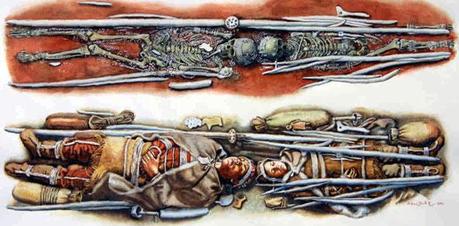Death is big business. This past year, Americans spent $15 billion on funeral related expenses. Americans are not outliers when it comes to death spending; funeral related expenditures around the world are estimated to be at least this much and probably more. Strangely, the ratio of death spending does not diminish in poorer countries. In fact, it is often higher. Death leaves many families destitute.
Although death industry marketing surely plays a role in some of this spending, it cannot account for most of it. Something else is going on and what that something is has ancient roots. In all likelihood, the earliest mortuary practices — in the form of deliberate burials which first appear in the archaeological record some 100,000 years ago — suggest (but do not require) soul beliefs.
While soul beliefs and deliberate burials are one thing, burials with elaborate grave goods and extended mourning rituals are another. One of the earliest and most spectacular examples of such a burial comes from Sunghir, Russia and is approximately 25,000 years old.

Illustration © Libor Balák
These burials included 13,000 ivory beads and because experiments show it takes about one hour to make each bead, 13,00o hours were invested in the beads alone. When the other grave goods are added, there may be 15,000 hours invested in these burials. In terms of today’s dollars (the average US wage is $17/hour), these burials cost $255,000, quite an expenditure for nomadic hunter-gatherers.
While this may seem extraordinary and probably was, more recent hunter-gatherers have also been known to invest heavily in mortuary and funerary rituals. In “Historical Mourning Practices Observed among the Cree and Ojibway Indians,” Paul Hackett notes that the Cree and Ojibway observed two primary mourning practices: “The first involved the abandonment or destruction of possessions,” including those of the deceased, close relatives, or both. The second “required the cessation of hunting for a prolonged period, almost invariably a year.”
While the first could be costly depending on the number and type of possessions abandoned or destroyed, the second could be a matter of life and death for people whose livelihoods depended on hunting. In many cases, these practices resulted in severe hardship for the mourners. Hackett notes that such practices were not unique to the Cree and Ojibway, and their wide distribution among Native American hunter-gatherers “suggests that they were of considerable antiquity, perhaps dating to the pre-Columbian period.” Considering the burials at Sunghir, it may be the case that hunter-gatherers around the world have practiced similar mourning rituals for tens of thousands of years.
One apparently unique feature of hunter-gather mortuary practices is the avoidance or non-curation of bones. Both the remains and possessions of the deceased were invested with spirits and power, both of which were to be treated with respect and then abandoned or kept at a distance. If proper ceremony was not observed, these items could result in misfortune.
These practices stand in sharp contrast to those observed in the earliest agricultural communities, with the Neolithic site of Catalhoyuk (7400-6200 BC) in southern Turkey being a prime example. At Catalhoyuk, treatment of the deceased was a two stage process. In his somewhat speculative survey of burials at Catalhoyuk, Macqueen observes that the body was exposed for defleshing, and after the bones had been bleached, they were buried (with grave goods) in the floors of homes. Rather than avoid skeletons as do nearly all hunter-gatherers, the farmers and herders of Catalhoyuk desired their proximity, going so far as to live and sleep with them.
While this may seem macabre to some, it makes considerable sense given the altered dynamics of property and power in agricultural communities. As Ian Hodder explains in “Daily Practice and Social Memory at Catalhoyuk,” these spatial and temporal dynamics are dramatically different from those found in hunting and gathering societies:
The key themes of the Neolithic of the Near East, such as sedentism, aggolomeration, and domestication, as well as more specific themes such as the treatment of the dead and veneration of ancestors, all involve changes in temporality, memory, and relationships with the past.
It is often argued that early forms of power in the Neolithic of the Near East and Europe were linked to delayed return systems, links to ancestors, repetitive practices at monuments to the dead, and the construction of greater temporal depth to activities (as in the construction of lineages).
The Neolithic transition from foraging to agriculture brought with it many changes, including in mortuary practices and mourning rituals. While some have speculatively argued that Paleolithic hunter-gatherers engaged in a form of ancestor worship and that ancestors functioned as supernatural surveillance agents charged with norm enforcement, there is scant evidence of this. Ancestor cults, in other words, are latecomers in the history of supernatural belief and practice.
References:
Hackett, P. (2005). Historical Mourning Practices Observed among the Cree and Ojibway Indians of the Central Subarctic Ethnohistory, 52 (3), 503-532 DOI: 10.1215/00141801-52-3-503
Macqueen, J. (1978). Secondary Burial at Catal Huyuk Numen, 25 (3) DOI: 10.2307/3269537
Hodder, I., & Cessford, C. (2004). Daily Practice and Social Memory at Çatalhöyük American Antiquity, 69 (1) DOI: 10.2307/4128346


